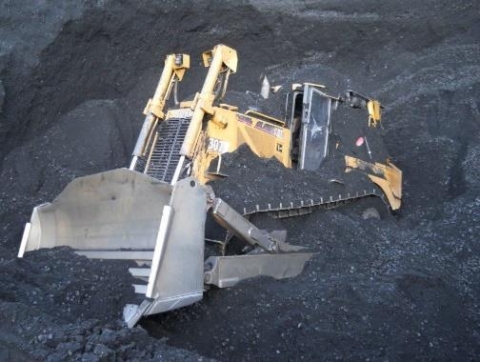On March 5, 2020, an operator was using a Caterpillar D8T bulldozer on a coal surge pile near a load-out feeder location when the surge pile collapsed, engulfing the bulldozer and trapping the operator inside the cab. The operator was uninjured because the bulldozer was equipped with:
- High-strength glass that prevented coal from entering the operator’s cab; and
- Two Self Contained Self-Rescuers (SCSRs) which provided the equipment operator sufficient breathable air throughout the two-hour rescue effort.
MSHA urges all mine operators and contractors to be aware of hazards associated with operating equipment on or near coal surge piles and to follow the safety practices listed below.

Best Practices for Working On or Near Surge Piles
- Install high-strength glass certified to support at least 40 psi with a frame and supports designed to withstand the added loading.
- Stock cabs with safety equipment. Securely store additional SCSRs, flashlights, cooling packs and drinking water in equipment cabs.
- Mark feeder locations and provide visual indicators to identify active feeders.
- Stay stable. Don’t operate equipment directly over feeders, stay away from the unstable drawhole edges and ensure that dozers use the “double blade” pushing method by leaving the first blade of material short of the drawhole edge and bumping it into the drawhole using the second blade of material.
- Always keep the dozer blade between the cab and the feeder.
- Provide gates on feeders or ensure that coal cannot discharge when a feeder is not operable.
- Be aware of surge pile conditions such as excessive material settling in piles that have been idled, excessive compaction of material layers overlying the feeders, and freezing weather conditions that create hidden cavities when the material is “bridged” over a feeder.
- Make sure the equipment operator can remotely shut-down the stacker and feeder belts from the equipment cab.
- Install closed-circuit TV monitors so feeder operators can observe conditions and activities on the surge pile and provide two-way radio communication.
- Prevent foot traffic on surge piles and provide adequate warning signs.
- Use remote-controlled dozers on surge piles.
- Provide adequate training for all surge pile workers to include specialized training on alarm response, equipment needs and rescue and recovery plans involving engulfed equipment.


